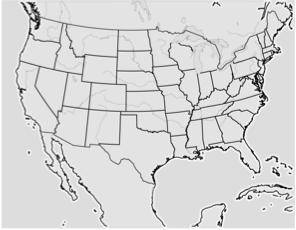HELP PLEASEE 20 POINTS Forecast like a Meteorologist Exploration
Part 1
Use th...

Biology, 06.03.2020 22:37, sabrinarasull1pe6s61
HELP PLEASEE 20 POINTS Forecast like a Meteorologist Exploration
Part 1
Use the data on the weather map from July 4, 2006 to create a weather map and a weather forecast for the next day. Include the locations of fronts, highs, lows, and precipitation.
Use these forecasting tips to create the weather maps:
• If there is a lot of water vapor in the air and a cold front is approaching, precipitation is most likely on its way, too.
• A change in air pressure means there will most likely be a change in weather. Falling air pressure generally means rain. Rising air pressure generally means clearing skies.
• Air masses and fronts generally move west to east.
Use these tips to create a written forecast:
• Write as if you are a weather forecaster explaining the forecast to a viewing audience.
• Explain the weather maps.
• Describe changes in pressure, temperature, and precipitation.
Weather Map: July 5, 2006
Forecast: July 5, 2006
Apprentice Self-Evaluation
Evaluate your own work by answering these questions.
1. What was most challenging about forecasting the weather?
2. How did this project prepare you to be a real meteorologist?
3. What do you need more practice doing before you are promoted to entry-level meteorologist?
Part 2
Create a Map
Obtain or draw a map of your state or area. Describe the geography of the area. Draw the geographical features of your area. Geographical features can include, but are not limited to, the following:
• Mountains
• Large bodies of water such as the Great Lakes, oceans, or bays
• Plains
Remember to submit your map with the assignment.
Data Collection
For ten days, record the temperature, air pressure, precipitation, and wind speed/direction for your area.
Date Temperature (˚F) Air pressure (mm of Hg) Precipitation (in.) Wind speed and direction
Data Analysis
Analyze the weather data and map to answer the questions.
1. What weather patterns are present in your area?
2. How do the geography and geographical features of your area affect the temperature?
3. How do the geography and geographical features of your area affect the precipitation?
4. How do the geography and geographical features of your area affect the weather in the area?


Answers: 1
Other questions on the subject: Biology

Biology, 22.06.2019 05:20, kay3940
The large increase in atmospheric carbon dioxide in the last 50 years most likely comes from a. an increase in cellular respiration b. increased decomposition by bacteria c. an increase in the burning of fossil fuels d. an increase in photosynthesis
Answers: 3

Biology, 22.06.2019 08:40, Josephzaz
Asquirrel population lives in an area. over many years, a river in that area grows wider and stronger, eventually forming a canyon. the squirrel populations on the two sides of the canyon can no longer mate with each other and ultimately form distinct species. this is an example of
Answers: 1

Biology, 22.06.2019 13:00, mbonilla073
The mixture of sperm and fluids from the seminal vesicles, prostate gland, and cowper's glands is called
Answers: 1
Do you know the correct answer?
Questions in other subjects:

Mathematics, 28.08.2019 07:30

Social Studies, 28.08.2019 07:30

Mathematics, 28.08.2019 07:30


Chemistry, 28.08.2019 07:30

Mathematics, 28.08.2019 07:30

Biology, 28.08.2019 07:30

Geography, 28.08.2019 07:30


Physics, 28.08.2019 07:30






